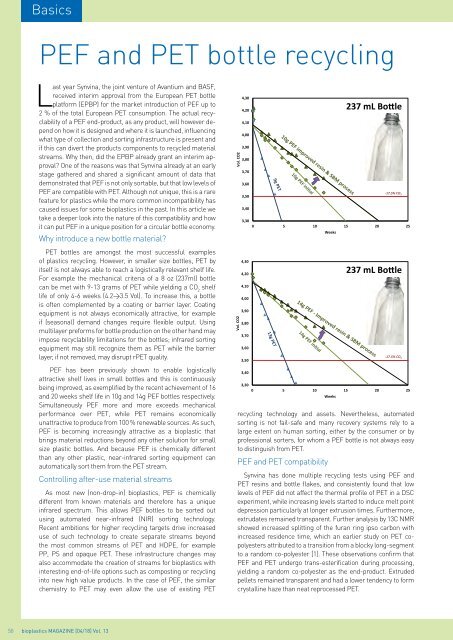Issue 04/2018
bioplasticsMAGAZINE_1804
bioplasticsMAGAZINE_1804
You also want an ePaper? Increase the reach of your titles
YUMPU automatically turns print PDFs into web optimized ePapers that Google loves.
Basics<br />
PEF and PET bottle recycling<br />
Last year Synvina, the joint venture of Avantium and BASF,<br />
received interim approval from the European PET bottle<br />
platform (EPBP) for the market introduction of PEF up to<br />
2 % of the total European PET consumption. The actual recyclability<br />
of a PEF end-product, as any product, will however depend<br />
on how it is designed and where it is launched, influencing<br />
what type of collection and sorting infrastructure is present and<br />
if this can divert the products components to recycled material<br />
streams. Why then, did the EPBP already grant an interim approval?<br />
One of the reasons was that Synvina already at an early<br />
stage gathered and shared a significant amount of data that<br />
demonstrated that PEF is not only sortable, but that low levels of<br />
PEF are compatible with PET. Although not unique, this is a rare<br />
feature for plastics while the more common incompatibility has<br />
caused issues for some bioplastics in the past. In this article we<br />
take a deeper look into the nature of this compatibility and how<br />
it can put PEF in a unique position for a circular bottle economy.<br />
Why introduce a new bottle material?<br />
PET bottles are amongst the most successful examples<br />
of plastics recycling. However, in smaller size bottles, PET by<br />
itself is not always able to reach a logistically relevant shelf life.<br />
For example the mechanical criteria of a 8 oz (237ml) bottle<br />
can be met with 9-13 grams of PET while yielding a CO 2<br />
shelf<br />
life of only 4-6 weeks (4.2→3.5 Vol). To increase this, a bottle<br />
is often complemented by a coating or barrier layer. Coating<br />
equipment is not always economically attractive, for example<br />
if (seasonal) demand changes require flexible output. Using<br />
multilayer preforms for bottle production on the other hand may<br />
impose recyclability limitations for the bottles; infrared sorting<br />
equipment may still recognize them as PET while the barrier<br />
layer, if not removed, may disrupt rPET quality.<br />
PEF has been previously shown to enable logistically<br />
attractive shelf lives in small bottles and this is continuously<br />
being improved, as exemplified by the recent achievement of 16<br />
and 20 weeks shelf life in 10g and 14g PEF bottles respectively.<br />
Simultaneously PEF more and more exceeds mechanical<br />
performance over PET, while PET remains economically<br />
unattractive to produce from 100 % renewable sources. As such,<br />
PEF is becoming increasingly attractive as a bioplastic that<br />
brings material reductions beyond any other solution for small<br />
size plastic bottles. And because PEF is chemically different<br />
than any other plastic, near-infrared sorting equipment can<br />
automatically sort them from the PET stream.<br />
Controlling after-use material streams<br />
As most new (non-drop-in) bioplastics, PEF is chemically<br />
different from known materials and therefore has a unique<br />
infrared spectrum. This allows PEF bottles to be sorted out<br />
using automated near-infrared (NIR) sorting technology.<br />
Recent ambitions for higher recycling targets drive increased<br />
use of such technology to create separate streams beyond<br />
the most common streams of PET and HDPE, for example<br />
PP, PS and opaque PET. These infrastructure changes may<br />
also accommodate the creation of streams for bioplastics with<br />
interesting end-of-life options such as composting or recycling<br />
into new high value products. In the case of PEF, the similar<br />
chemistry to PET may even allow the use of existing PET<br />
Vol. CO2<br />
Vol. CO2<br />
4,30<br />
4,20<br />
4,10<br />
4,00<br />
3,90<br />
3,80<br />
3,70<br />
3,60<br />
3,50<br />
3,40<br />
3,30<br />
0 5 10 15 20 25<br />
4,30<br />
4,20<br />
4,10<br />
4,00<br />
3,90<br />
3,80<br />
3,70<br />
3,60<br />
3,50<br />
3,40<br />
Weeks<br />
3,30<br />
0 5 10 15 20 25<br />
Weeks<br />
237 mL Bole<br />
-17.5% CO 2<br />
237 mL Bole<br />
-17.5% CO 2<br />
recycling technology and assets. Nevertheless, automated<br />
sorting is not fail-safe and many recovery systems rely to a<br />
large extent on human sorting, either by the consumer or by<br />
professional sorters, for whom a PEF bottle is not always easy<br />
to distinguish from PET.<br />
PEF and PET compatibility<br />
Synvina has done multiple recycling tests using PEF and<br />
PET resins and bottle flakes, and consistently found that low<br />
levels of PEF did not affect the thermal profile of PET in a DSC<br />
experiment, while increasing levels started to induce melt point<br />
depression particularly at longer extrusion times. Furthermore,<br />
extrudates remained transparent. Further analysis by 13C NMR<br />
showed increased splitting of the furan ring ipso carbon with<br />
increased residence time, which an earlier study on PET copolyesters<br />
attributed to a transition from a blocky long-segment<br />
to a random co-polyester [1]. These observations confirm that<br />
PEF and PET undergo trans-esterification during processing,<br />
yielding a random co-polyester as the end-product. Extruded<br />
pellets remained transparent and had a lower tendency to form<br />
crystalline haze than neat reprocessed PET.<br />
50 bioplastics MAGAZINE [<strong>04</strong>/18] Vol. 13


















